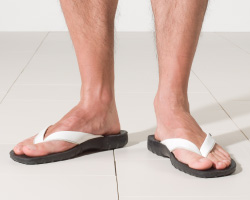
Fungi are a normal part of our environment and are generally harmless. But when a fungus infects a part of the human body, it can be persistent and painful.
When this happens in the nails, it's called onychomycosis (AH-nih-koh-my-KOH-sihs).
What does it look like?
Nails infected by a fungus usually turn white or yellow but may also turn green or black. The nail may thicken and debris may collect underneath it. The nail may also start to separate from the skin.
A fungus that infects the nails often infects the surrounding skin as well, causing itching and flaking. This can sometimes lead to a bacterial infection, making the skin warm, red, swollen and itchy.
What's happening?
Fungi thrive in warm, moist areas, which is why they're more likely to affect toenails than fingernails. A fungus gets into your nail through a crack. In time, the fungus may penetrate the entire nail and spread to other nails.
Who's at risk?
Fungal nail infections become more common with age and are most common in adults older than 60. People with diabetes or circulation problems are especially susceptible.
People whose hands or feet stay damp for long periods (such as people who wear heavy boots all day or who wash dishes in restaurants) are also at higher risk.
Frequently walking barefoot in locker rooms also increases the risk of a fungal toenail infection.
What can I do?
Because fungi can hang around for months before causing an infection, a good foot care routine can prevent an infection from taking hold.
The American Podiatric Medical Association offers the following tips:
- Wash your feet regularly with soap and water, and dry them thoroughly.
- Wear shower shoes in public areas.
- Change shoes, socks or hosiery every day. Avoid tight hosiery altogether.
- Clip your toenails straight across, making sure they don't extend beyond the end of the toe.
- Wear shoes made of breathable materials that fit well.
- If you think a nail may be infected, don't polish it—this traps moisture and can make the infection worse.
If you do get a fungal infection, the American Academy of Family Physicians recommends these steps to care for your nails:
- Keep your nails trimmed short, and file down thick areas.
- Use different trimmers and files on infected and healthy nails.
- When you're doing work that gets your hands wet, wear waterproof gloves.
- Put on clean, dry socks made of wicking material every day. Change them if they get damp or wet from sweat or anything else. You can also put antifungal foot powder in your socks to help keep your feet dry.
- Wear shoes with a wide toe area and good support.
Can they be treated?
Several types of treatment may be used on fungal nails, depending on the type and severity of the infection.
Treatments may include:
- Over-the-counter liquid antifungal medicines applied directly to the nail.
- Antifungal medications taken by mouth.
- Surgery to remove the nail.
Reviewed 9/5/2025